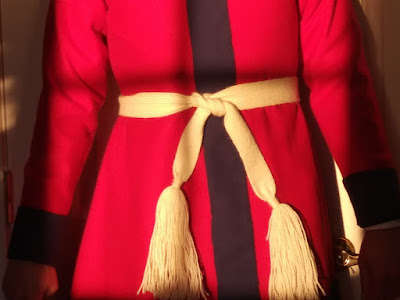Since Giannis Kadoglou alerted us to the idea of tablet weaving several years ago, I've wondered whether the narrow sash worn with Medo-Persian and Elamite dress was made by this method or by cutting and stitching. I had first made some sashes in 2013 from cotton webbing, but the one I wore in 2015 was essentially a double-wide strip cut from wool yardage, sewn into a tube, inverted, and gathered at the ends. This works well enough, but several of us at Amphictyonia have long been of the suspicion that the zigzags shown on the Egyptian statue of Darius the Great were made by tablet-weaving instead.
Over the summer, I gave a shot at tablet-weaving my own belt from hemp. My conclusion? Practice a lot, or leave it to the professionals.
I contacted Aleksandra Zwawiak, proprietor of SagaWeaving (UK), about the possibility of a custom belt three weeks ago after seeing that she had produced belts with apparently the same weave pattern. We discussed the specifications and settled on a design over a couple of days. She ordered the yarn right away and had created the belt within a few days after that, and it arrived at my door this morning. Aleksandra was very pleasant to work with and, having some glimmer of the effort and care this technique requires, I'm impressed at the quality and speed of her work as well, as how modestly-priced it is.
I requested a solid off-white or beige as might be obtained from a white sheep, and a width of 35-40mm - it comes in at a hair under 40mm. The belt is a bit thick, but it has to be for the weave to be visible, and the wool is very soft and easy to tie. It differs from the Egyptian statue in not having the lengthwise stripes with apparent Holbein stitching. It's my best guess that these represent appliqued trim rather than part of the sash's weave, so I didn't expect or request that they be included.
(I seem to be having a bit of trouble with square knots lately.) The standard length of 135cm between the tassels is just about right for my waist (around 30 inches or 76cm); the square knot takes up more length than a simple knot would. The loose ends of the tassels will have to be trimmed almost to nothing, but I haven't yet decided how to eliminate the risk of the knots becoming untied once this is done, so I asked Aleksandra to leave them at full length in the meanwhile. A possible solution would be to immediately soak the trimmed knots in melted rosin-beeswax glue to turn them into solid lumps; this would be permanent and waterproof, though the discoloration might look unsightly.
It must be emphasized that this is a speculative reconstruction. I think it's a highly plausible one, as good as any other, and fits the available evidence.


This comment has been removed by a blog administrator.
ReplyDelete